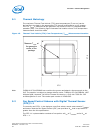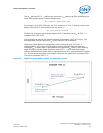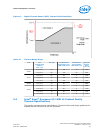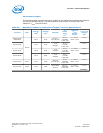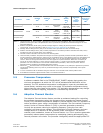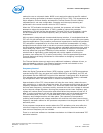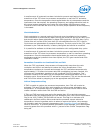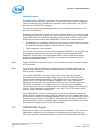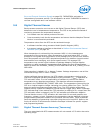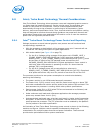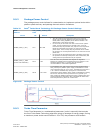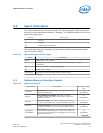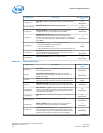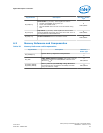
PROCHOT# Signal
An external signal, PROCHOT# (processor hot), is asserted when the processor core
temperature has exceeded its specification. If Adaptive Thermal Monitor is enabled (it
must be enabled for the processor to be operating within specification), the TCC will
be active when PROCHOT# is asserted.
The processor can be configured to generate an interrupt upon the assertion or de-
assertion of PROCHOT#.
By default, the PROCHOT# signal is set to bi-directional. However, it is recommended
to configure the signal as an input only. When configured as an input or bi-directional
signal, PROCHOT# can be used for thermally protecting other platform components
should they overheat as well. When PROCHOT# is driven by an external device:
• The package will immediately transition to the minimum operation points (voltage
and frequency) supported by the processor and graphics cores. This is contrary to
the internally-generated Adaptive Thermal Monitor response.
• Clock modulation is not activated.
The TCC will remain active until the system de-asserts PROCHOT#. The processor can
be configured to generate an interrupt upon assertion and de-assertion of the
PROCHOT# signal. Refer to the appropriate Platform Thermal Mechanical Design
Guidelines (see Related Doucments section) for details on implementing the bi-
directional PROCHOT# feature.
Note: Toggling PROCHOT# more than once in 1.5 ms period will result in constant Pn state
of the processor.
Note: A corner case exists for PROCHOT# configured as a bi-directional signal that can
cause several milliseconds of delay to a system assertion of PROCHOT# when the
output function is asserted.
As an output, PROCHOT# (Processor Hot) will go active when the processor
temperature monitoring sensor detects that one or more cores has reached its
maximum safe operating temperature. This indicates that the processor Thermal
Control Circuit (TCC) has been activated, if enabled. As an input, assertion of
PROCHOT# by the system will activate the TCC for all cores. TCC activation when
PROCHOT# is asserted by the system will result in the processor immediately
transitioning to the minimum frequency and corresponding voltage (using Frequency
control). Clock modulation is not activated in this case. The TCC will remain active
until the system de-asserts PROCHOT#.
Use of PROCHOT# in input or bi-directional mode can allow VR thermal designs to
target maximum sustained current instead of maximum current. Systems should still
provide proper cooling for the Voltage Regulator (VR), and rely on PROCHOT# only as
a backup in case of system cooling failure. The system thermal design should allow
the power delivery circuitry to operate within its temperature specification even while
the processor is operating at its Thermal Design Power.
5.7
THERMTRIP# Signal
Regardless of whether or not Adaptive Thermal Monitor is enabled , in the event of a
catastrophic cooling failure, the processor will automatically shut down when the
silicon has reached an elevated temperature (refer to the THERMTRIP# definition in
Processor—Thermal Management
Intel
®
Xeon
®
Processor E3-1200 v3 Product Family
Datasheet – Volume 1 of 2 June 2013
72 Order No.: 328907-001



